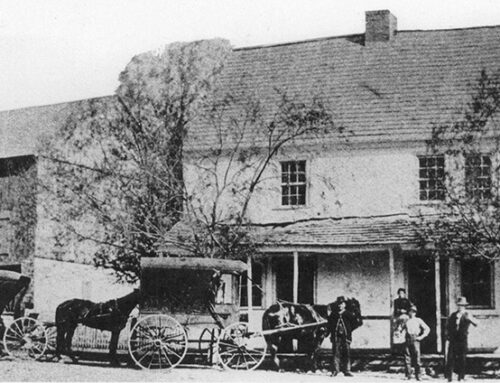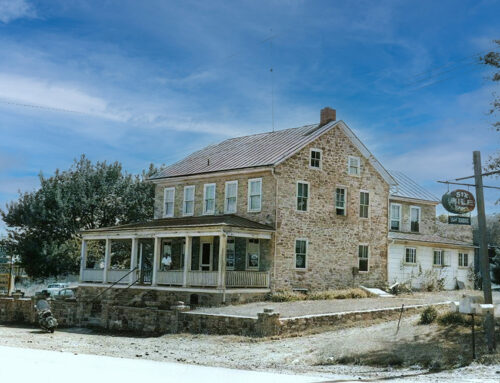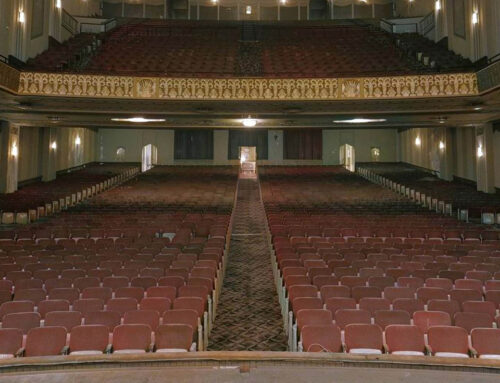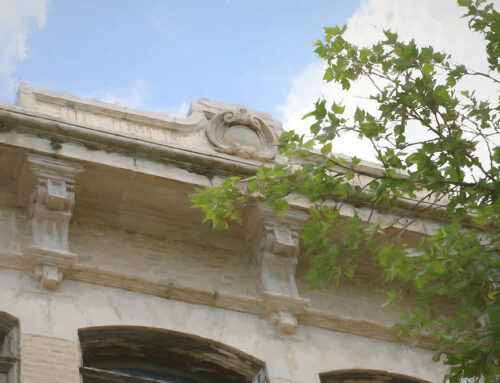West of the Reading Hospital and Medical Center, between Seventh Avenue and Park Road, on the Wyomissing-West Reading border, stands the imposing Masonic Temple, dedicated in 1963. The square on which it is located gives little hint of the history associated with the site.
Occupying most of this block until 1966 was a beautiful lake, dubbed Weiser Lake, commonly referred to as “The Mine Hole.”
For ice skaters, fisherman, and adventuresome swimmers of the region, this was a favorite point to congregate. Here the encircling trees mirrored a shimmering likeness on the waters below to provide an excellent subject for both artists and photographers. No less delightful was the winter scene when clad skaters eagerly claimed the frozen Mine Hole for their arena.
Below: Snow in November 1952 helped create this peaceful scene of the area at Weiser Lake, looking toward the Reading Hospital.

Below: Ice skating on Weiser Lake, a landmark-site on the West Reading/Wyomissing border.

The story of the Mine Hole is both interesting and important. For had the mine remained in operation Reading’s two leading suburbs, West Reading and Wyomissing, would today be changed physically and industrially. But because of Weiser Lake thousands of tons of fine red hematite ore still lie buried in rich veins running as far north as 7th Avenue and Franklin Street in West Reading and as far west as Reading Boulevard in Wyomissing.
The old open pit mine is said to have been in operation for more than a century, being operated intermittently by the Wetherhold, Reichert, Seitzinger and other families.
Iron ore excavated from this site was of good quality, yielding an average of six per cent iron. Between 25 and 35 men were employed in digging operations. With the aid of picks and shovels the ore was extracted and loaded on carts. The carts were then pulled up a ramp by means of cables. Upon reaching the surface the carts were transported by mule teams to the loading platform known as “the Wharf” , located along the Lebanon Valley Railroad. Six mule teams were employed to handle the transportation. In slow, steady procession the creaking carts rumbled over the dusty dirt roads to the railroad where the ore was dumped and loaded on the cars by hand. Freight shipments were usually made to two Sheridan furnaces. Despite the slow manual work involved, mining costs were as low as $1.00 per ton.
Below: Seitzinger’s Iron Mint Site, circa 1880. Present site of Masonic Temple and Scottish Rite Cathedral Grounds on the West Reading/Wyomissing border west side of Reading Hospital.

Virtually all the mining operations in Berks were affiliated with certain furnaces, often by binding legal agreement. Seitzinger’s was no exception. William M. Kauffman & Co., in consideration of one-dollar-a-ton royalty, had exclusive rights to the iron taken from the tract.
Aaron Adams, Sr., formerly of 617 Penn Ave., West Reading, held the contract to haul the ore. He tenanted the 307-acre Seitzinger farm for 12 years, which spanned both the opening and closing of the mine which the tract contained.
Adams hauled the ore, estimated to have totaled between 10,000 and 15,000 tons, in drays pulled by six-mule-teams to a wharf along the Lebanon Valley Railroad near present-day Park Road. From here, shipment was made to the two Kauffman furnaces at Sheridan, Lebanon County.
By the mid-1870s the mine was operating at full capacity. On some days 50 tons of ore were removed by a crew that usually numbered about 35.
The main pit was about 50 feet deep. It is reported that veins of ore ran as far as Seventh Avenue and Franklin Street in West Reading and Wayne Avenue, west of Reading Boulevard, in Wyomissing.
Incidentally, one-quarter of the mine hole was in West Reading and the rest in Wyomissing.
On Sept. 28, 1876, something happened that put an end to operations.
According to Adams, who recounted the event 37 years later when 85, the last half of September had been very wet. On the 27th it rained torrentially. Early the following day while he was in the orchard surveying the extent of the damage and lamenting the fact 1,000 bushels of apples were knocked from his trees someone came running to tell him the mine was flooding rapidly.
The men had reported to work to find a good-sized spring flowing in one part of the three-acre quarry-like excavation. The flow of the spring grew faster and greater in volume. Before long, water began shooting out of the earth with great force.
Sell’s version of the story is more spectacular. He claimed he was standing on the north edge of the mine hole looking down when 100 feet in front of him his attention was directed to a 4-foot-square spot at a depth of about 50 feet, in the yellow clay, which had been wet for some time.
The spot was getting wetter and wetter. A few minutes later there was a noise like an explosion. A stream of water – the thickness of a man’s body – shot 20 feet in the air, making a sound like a geyser.
Down in the pit about 35 men, seeing what was occurring, dropped their tools and ran for their lives.
Fortunately there was no loss of life. All of the workmen were able to scramble to safety, and inasmuch as the mules were used only on the surface for hauling purposes they were not endangered. The two pumps formerly used to drain the mine, having a capacity of 40 barrels a minute, ran continuously for 66 hours with little effect. By Oct. 1, water had risen to a height of 35 feet. Because of the rapid flooding, nothing was saved. All the tracks, cars, and tools were left in the pit.
For two days and two nights large pumps were at work in an effort to lower the water level. But the subterranean stream was being nourished by the Schuylkill River and the Wyomissing Creek. Finally the pumps were abandoned when it became apparent that a veritable river had been tapped. The water continued to rise until it reached the surface bordering the excavation, but did not overflow. The pressure seemed to abate when the pit was filled to capacity.
At one time a surveyor was employed to gauge the level between the bottom of the Mine Hole and the Wyomissing Creek, with the idea that perhaps a trench could be dug to carry off part of the water. The bed of the old mine was found to be at least 15 feet below that of the creek, thus necessitating an expensive pumping operation. Consequently the project was abandoned.
George F. Baer, an attorney, was summoned to the scene since he was the only trustee of the Seitzinger estate living close to the area.
Many conferences were held but no solution to the problem could be found. It was estimated the rush of water opened a cavity in the earth large enough to contain a large barrel.
The trustees engaged a surveyor to gauge the levels between the bottom of the mine and the bed of the Wyomissing Creek some distance away. It was found that if a trench were dug to drain the mine, it would carry off only part of the water. The lower point of excavation was at least 15 feet below the creek bed. To pump the remainder of the water from the quarry would be enormously expensive.
In order to stabilize the water level, a 15-inch-diameter drainage sewer was constructed along Rimar Avenue, south of the mine hole, which reduced the groundwater level.
Under the ownership of the Wyomissing Development Company the potentialities of the site as a spot of beauty were developed. First a difficult engineering task was undertaken in order to encase the spring in a concrete wall. The work was accomplished after many weeks of pumping in which an electrically driven centrifugal pump was used. This done, the spring was encased in a solid wall of concrete and the bottom of the lake was cleaned. Lawn, trees and shrubbery were added to further enhance the beauty of the newly formed lake, which was then named for Conrad Weiser.
Below: In this photo from the 1920s, the then new residential development, north of the mine hole, is visible. Eighth Avenue is running diagonally to the right, and Park Road is visible, left center. The dwellings were built by Wyomissing Development Co., Ferdinand Thun, president; Henry Janssen, vice president; Gustav Oberlander, treasurer; and I. F. Impink, secretary and manager.

Below: View of Weiser Lake, circa 1927.

In 1957 the mine hole was included in 20 acres of land which the Masonic Centre Foundation obtained on option from the Wyomissing Industries under plans to erect an $800,000 Masonic temple. This structure materialized six years later.
In 1966, it was decided to accept clean fill to close the hole. By June of 1969 the lake was half its original size, and by early September 1971 it covered only one acre. The Eagle reported on Sept. 30 that the remaining “lake” measured but 20 feet in length, 6 feet in width, and 2 feet in depth. This prompted an emergency “save the fish” operation.
As might be expected, many fish perished before they could be rescued. About 40 large carp, 14 inches to 2 feet long, and several hundred crappy bass were transported from the site in large garbage cans.
Now, there is little left at the location except some vintage trees along Park Road that once encircled the hole to inform passers-by of what once existed here. Those who shared in its history, though, won’t forget.
Below: View of remains of Weiser Lake, circa 2018.







Leave A Comment